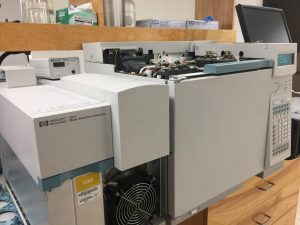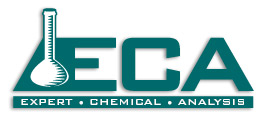Gas Chromatography/GC-MS
Gas Chromatography/GC-FID/GC-TCD/GC-MS
 ECA has tremendous experience and expertise in the technique of Gas Chromatography. Gas Chromatography is a technique where volatile or semi-volatile samples in a solvent are injected into a chromatograph where the mixture is vaporized and carried through a capillary column using an inert gas. The analytes in the mixture are separated by their interaction with the coated stationary phase. The analytes that have more affinity for the stationary phase will be delayed in the elution and the analytes with less affinity for the stationary phase will be eluted more quickly. Gas Chromatography can be used to analyze gases, liquids, and some volatile solids.
ECA has tremendous experience and expertise in the technique of Gas Chromatography. Gas Chromatography is a technique where volatile or semi-volatile samples in a solvent are injected into a chromatograph where the mixture is vaporized and carried through a capillary column using an inert gas. The analytes in the mixture are separated by their interaction with the coated stationary phase. The analytes that have more affinity for the stationary phase will be delayed in the elution and the analytes with less affinity for the stationary phase will be eluted more quickly. Gas Chromatography can be used to analyze gases, liquids, and some volatile solids.
Gas Analysis using GC-TCD/ GC-MS:
Gases are divided into organic and inorganic gases. Inorganic gases are usually separated by a molecular sieve column (usually zeolites) or a porous polymer like Poropak. ECA has the capability to separate both fixed inorganic gases and organic gases. We regularly analyzed the gases Hydrogen, Oxygen, Nitrogen, Carbon Dioxide, and Carbon Monoxide. Another group that is commonly needed is the light hydrocarbons from C1 (methane) to C6 (hexane) and all light gases in between. We also routinely analyze specially prepared gases like NF Nitrogen and Breathing Air for specification testing to verify that they meet their purity claims.
Liquid Samples/ Volatile and Semi-Volatile:
For larger volatile and semi-volatile compounds, Gas Chromatography with coated capillary columns is used with a different group of detectors. ECA has Flame Ionization Detectors (FID) that are used most commonly with standard gas chromatography. These detectors are very linear but have a difference response to polar and nonpolar compounds. The FID combusts the organic chemical in a hydrogen/oxygen flame and a polarizing voltage attracts electrons to a collector to produce a current. This current is sensed by an electrometer and produces a voltage which is amplified, converted to a digital signal, and sent to the data system. The FID is the most often used detector in gas chromatography. Other detectors that we use are the Thermal Conductivity Detector (TCD) which responds to the thermal conductivity of the compound in the gas stream. This detector is a universal detector and is not quite as sensitive as the FID, but, it used commonly for the analysis of inorganic compounds that cannot be detected by FID. We also sometimes employ the Photo Ionization Detector which is somewhat more sensitive to aromatic compounds. We also have the Electron Capture Detector (ECD) which is very sensitive to halogens and compounds with oxygen–containing groups. This detector is commonly used for Organo-Chlorine Pesticides.
GC-MS/ A powerful Analytical Tool:
The last detector is the Mass Selective Detector which when combined with the Gas Chromatography system is called GC-MS. This detector responds to ionized fragments of molecules and is a universal detector. The power of GC-MS is that the detector causes molecular fragments that can be used as a “fingerprint” of the molecule and can be used to develop libraries of spectra for given compounds. The GC-MS can be used to identify unknown compounds by searching these libraries.
ECA has nearly every type of capillary column and packed column for the separation of all types of chemical substances. Any substance that has a boiling point between -268.9°C (Helium) to 400+ °C (petroleum hydrocarbons) can usually be analyzed using gas chromatography. We have the capability to analyze nearly all compounds that are amenable to these techniques.
Please give us a call to help you with any chemical analysis projects that involve gases, or volatile and semi-volatile liquids. We have extensive expertise in these areas.
